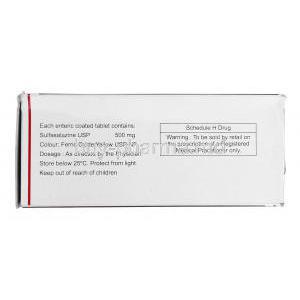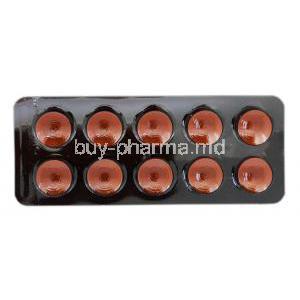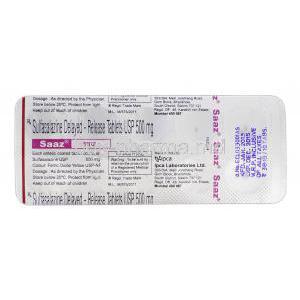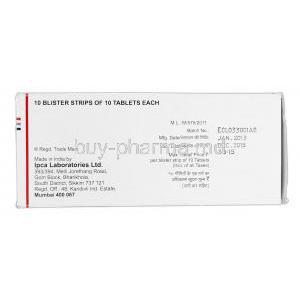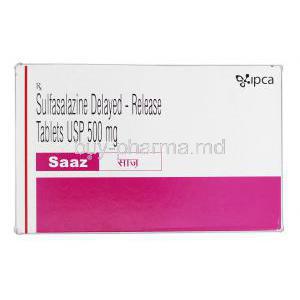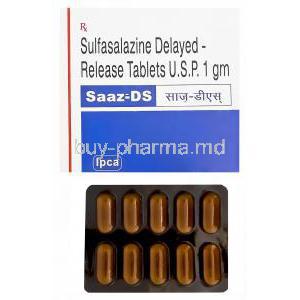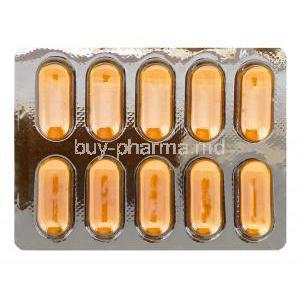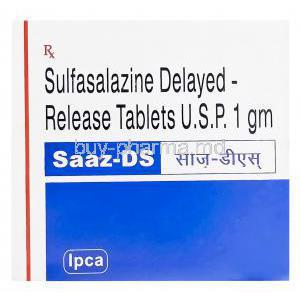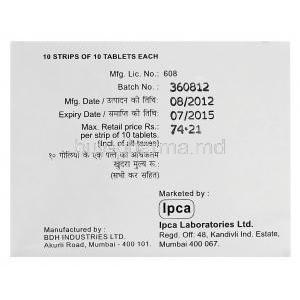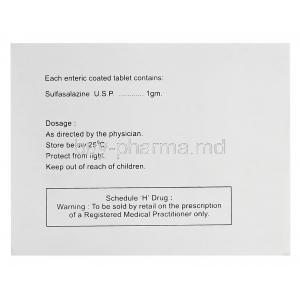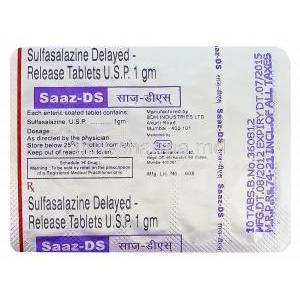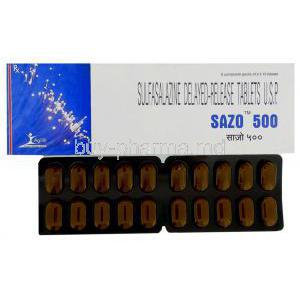Introduction to Saaz (Sulfasalazine)
Saaz, known generically as sulfasalazine, belongs to the group of disease-modifying antirheumatic drugs (DMARDs). It has long been utilized to suppress inflammation and regulate aberrant immune responses in chronic conditions. Its dual heritage as a sulfonamide and salicylate derivative lends it unique pharmacological properties.
Developed in the early 20th century, sulfasalazine was initially designed to target inflammatory bowel disorders. Over time, its therapeutic scope widened as clinicians observed its value in autoimmune joint diseases. This evolution cemented its place in both gastroenterology and rheumatology.
Composition and Formulations
The active ingredient in Saaz is sulfasalazine, a compound composed of sulfapyridine and 5-aminosalicylic acid (5-ASA) bound together. After ingestion, intestinal bacteria cleave the bond to release the active metabolites.
- Dosage forms include standard tablets and enteric-coated tablets to minimize gastric irritation.
- Strengths commonly available are 500 mg preparations.
- Inactive ingredients such as cellulose, starch, and magnesium stearate stabilize the formulation.
Sulfasalazine vs mesalamine
Sulfasalazine is a combination drug that contains the active anti-inflammatory agent 5-ASA bound to a sulfapyridine molecule, which can cause more side effects and require monitoring. Mesalamine delivers 5-ASA without the sulfapyridine component, leading to fewer systemic side effects like low sperm count and fewer allergic reactions in people sensitive to sulfa drugs or aspirin. Mesalamine is typically taken once daily in a delay-release tablet, while sulfasalazine formulations are taken multiple times a day.
Sulfasalazine vs methotrexate
Methotrexate can cause serious side effects like low white blood cells and kidney problems, while sulfasalazine commonly causes stomach issues like nausea and indigestion. Methotrexate is not safe during pregnancy, whereas sulfasalazine might not be safe for people with allergies to sulfa drugs.
Sulfasalazine vs hydroxychloroquine
Sulfasalazine generally provides an earlier and faster response than hydroxychloroquine, though both drugs are considered effective over time, with no significant differences in disease activity at 48 weeks in one study. Sulfasalazine is associated with a higher rate of withdrawal due to adverse reactions, while hydroxychloroquine is more often associated with a lack of efficacy.
Sulfasalazine and folic acid
If you're pregnant and taking sulfasalazine, you should also take folic acid tablets. This is because sulfasalazine can reduce your levels of folic acid. Folic acid reduces the risk of having a baby born with defects of the brain, spine or spinal cord, such as spina bifida.
Sulfasalazine Mechanism of Action: How Saaz Works
The therapeutic efficacy of Saaz arises from multiple biochemical pathways. It is not a simple anti-inflammatory agent but rather an orchestrator of immune modulation.
- Anti-inflammatory effects: Suppresses cyclooxygenase activity and prostaglandin synthesis.
- Immunomodulation: Reduces T-cell proliferation and cytokine secretion, particularly TNF-α and IL-1.
- Gut microbiota interaction: Cleavage in the colon produces metabolites that exert localized anti-inflammatory action.
- Cellular modulation: Alters neutrophil chemotaxis and stabilizes cellular membranes, diminishing tissue destruction.
- sulfasalazine immunosuppression: it is considered to have a relatively low immunosuppressive effect compared to other DMARDs
Approved Medical Uses
Sulfasalazine Rheumatoid Arthritis
Saaz is widely prescribed for rheumatoid arthritis as part of a DMARD regimen. It alleviates pain, reduces swelling, and slows structural joint damage.
Ulcerative Colitis
As one of the earliest agents for ulcerative colitis, Saaz reduces mucosal inflammation, controls rectal bleeding, and maintains remission.
Sulfasalazine Crohn’s Disease
Although less potent compared to other therapies, sulfasalazine is beneficial in Crohn’s disease, particularly when colonic involvement is evident.
Ankylosing Spondylitis
For patients with axial involvement and peripheral arthritis, Saaz provides symptomatic relief and improves functional outcomes.
Off-Label Uses
- sulfasalazine psoriatic arthritis: Utilized when patients exhibit inadequate response to first-line agents.
- Juvenile idiopathic arthritis: Employed cautiously in pediatric populations for polyarticular forms.
- Autoimmune uveitis: Reduces recurrence of inflammatory eye disease.
- sulfasalazine for lupus: it's considered a third-line treatment for lupus patients.
- Other IBD variants: Sometimes used in indeterminate colitis.
- Dermatologic conditions: Evidence supports occasional use in lichen planus and cutaneous sarcoidosis.
Dosage and Administration
Sulfasalazine dosage
Dosage is individualized, initiated at lower levels to minimize intolerance, and gradually increased to therapeutic thresholds.
Sulfasalazine Dosage Rheumatoid Arthritis
Typically begins with 500 mg once or twice daily, escalating to 2–3 g daily in divided doses as tolerated.
Sulfasalazine Dosage for Ulcerative Colitis and Crohn’s Disease
Induction doses may reach 3–4 g daily, followed by maintenance dosing at 2 g daily to sustain remission.
Pediatric Dosage Considerations
Children may receive 40–60 mg/kg/day in divided doses, with careful monitoring of growth and blood parameters.
Dose Titration and Escalation Strategies
Slow increments reduce gastrointestinal intolerance and headache frequency. Gradual escalation enhances long-term adherence.
Administration Instructions
- Best taken with food to mitigate gastrointestinal upset.
- Swallow tablets whole; do not crush enteric-coated forms.
- Ensure adequate hydration to prevent crystalluria.
Side Effects of Saaz
Sulfasalazine Side Effects
- Nausea, vomiting, and appetite loss
- Headache and dizziness
- Abdominal discomfort and dyspepsia
- Cutaneous reactions such as rash and mild pruritus
Long-term Side Effects Sulfasalazine
- Severe hypersensitivity reactions including anaphylaxis
- Hepatotoxicity, manifesting as hepatitis or jaundice
- Myelosuppression leading to agranulocytosis or aplastic anemia
- Pulmonary complications such as fibrotic changes
- Male fertility disturbances, notably reversible oligospermia
Sulfasalazine Interactions
Concurrent administration with other drugs demands vigilance due to complex pharmacokinetic and pharmacodynamic interactions.
- Methotrexate: Increased toxicity risk due to overlapping myelosuppressive effects.
- Digoxin: Reduced bioavailability secondary to altered intestinal flora.
- Folic acid: Diminished absorption, necessitating supplementation.
- Antibiotics and immunosuppressants: May disrupt bacterial cleavage of sulfasalazine, altering efficacy.
- Anticoagulants: Potentiation of bleeding risk due to hepatic enzyme interference.
- Food and alcohol: Sulfasalazine and alcohol can exacerbate hepatic strain, while food intake generally improves tolerance.
Sulfasalazine Contraindications
Certain patient populations must avoid the use of sulfasalazine due to elevated risks of adverse outcomes. Contraindications include:
- Hypersensitivity to sulfonamides or salicylates: Individuals with known allergies may develop life-threatening reactions.
- Patients with porphyria: The drug can precipitate acute attacks by exacerbating porphyrin metabolism dysfunction.
- Severe hepatic or renal impairment: Impaired clearance may lead to systemic toxicity and organ failure.
- Intestinal or urinary obstruction: Risks of exacerbation and drug accumulation necessitate strict avoidance.
Warnings and Precautions
Sulfasalazine warnings
- Blood dyscrasias: Potential for agranulocytosis and aplastic anemia requires vigilance.
- Severe dermatologic reactions: Stevens-Johnson syndrome and toxic epidermal necrolysis represent rare but grave complications.
- Folic acid deficiency: Sulfasalazine interferes with folate absorption, demanding supplementation in long-term therapy.
Important Precautions
- Monitoring: Routine evaluation of complete blood counts and hepatic enzymes is essential.
- Ophthalmic surveillance: Particularly valuable in patients with associated uveitis to detect ocular complications.
- Hydration: Adequate fluid intake prevents crystalluria and protects renal function.
Sulfasalazine Alternatives
s mesalamine, balsalazide, and olsalazine
Careful Administration
Patients with Hepatic Impairment
Metabolism is compromised in hepatic insufficiency, necessitating reduced doses and frequent biochemical assessments.
Patients with Renal Impairment
Reduced excretion may heighten drug levels. Dosage adjustment and creatinine clearance monitoring safeguard against nephrotoxicity.
Patients with Asthma or Allergic Disorders
Heightened sensitivity may provoke bronchospasm or severe allergic manifestations. Cautious initiation with close observation is prudent.
Special Population Considerations
Administration in Elderly Patients
Elderly individuals demonstrate greater vulnerability to hepatotoxicity and bone marrow suppression. Periodic hematologic and hepatic evaluations are recommended.
Administration in Pregnant Women
Clinical data indicate relative safety during gestation, particularly for inflammatory bowel disease management. Nonetheless, folic acid supplementation is mandatory to mitigate teratogenic risks.
Administration in Nursing Mothers
Sulfasalazine and metabolites appear in breast milk. Infants may experience diarrhea or sensitization, requiring risk-benefit evaluation.
Administration in Children
- Approved in pediatric populations for juvenile idiopathic arthritis and inflammatory bowel disorders.
- Dosage adjustments are weight-based, ensuring therapeutic benefit while avoiding toxicity.
- Long-term therapy requires meticulous monitoring of growth parameters and laboratory indices.
Overdose Management
Excessive ingestion may manifest as seizures, renal insufficiency, or profound gastrointestinal upset. Emergency protocols include:
- Immediate gastric lavage to evacuate residual drug.
- Administration of activated charcoal in early phases.
- Supportive measures such as intravenous hydration, seizure control, and renal monitoring.
Storage and Handling Precautions
- Storage: Maintain in a cool, dry environment away from direct light and excessive humidity.
- Handling: Tablets should be intact; broken forms may increase risk of dust inhalation and instability.
- Disposal: Unused or expired medication should be discarded safely, preferably via pharmaceutical take-back programs.
Patient Counseling Information
Effective therapeutic outcomes hinge on proper patient education and compliance.
- Adherence: Consistent daily use ensures disease suppression and prevents relapses.
- Monitoring: Regular check-ups and laboratory assessments are crucial for early detection of complications.
- Warning signs: Patients must seek urgent care for fever, severe rash, persistent abdominal pain, or jaundice.
- Lifestyle advice:
- Maintain a balanced diet rich in folate.
- Stay well hydrated to support renal clearance.
- Avoid excessive alcohol intake to minimize hepatic strain.
- Discuss fertility concerns, especially in male patients, as reversible oligospermia may occur.
Saaz, Sulfasalazine FAQ
- What is a Saaz Tablet used for?
- Is Saaz a strong painkiller?
- How often should I take Saaz 500mg?
- How long does SaaZ take to work?
- What are the side effects of Saaz 500mg Tablet?
- What is the drug sulfasalazine used for?
- What are the long-term effects of taking sulfasalazine?
- Is sulfasalazine a class of antibiotics?
- Is weight gain a side effect of sulfasalazine?
- What are the benefits of taking sulfasalazine?
- What is a natural alternative to sulfasalazine?
- How long can you stay on sulfasalazine?
- Does sulfasalazine affect sleep?
- Which is better sulfasalazine or methotrexate?
- What is the most common side effect of sulfasalazine?
- Can sulfasalazine cause memory loss?
- What is 3 week sulfasalazine syndrome?
- Can sulfasalazine cause tiredness?
- What is the best time of day to take sulfasalazine?
- Can sulfasalazine affect your eyes?
- What vitamins should you not take with sulfasalazine?
- How do I know if sulfasalazine is working?
- What happens if you take sulfasalazine without food?
- Why does sulfasalazine cause weight loss?
- Is sulfasalazine a chemo drug?
- What does sulfasalazine do to your immune system?
- What is a substitute for sulfasalazine?
- What are the major side effects of sulfasalazine?
- What is the problem with sulfasalazine?
What is a Saaz Tablet used for?
Saaz Tablet is prescribed for inflammatory conditions like rheumatoid arthritis, psoriatic arthritis, ankylosing spondylitis, psoriasis, ulcerative colitis, and Crohn's disease. It functions by alleviating inflammation, pain, and swelling associated with these ailments.
Is Saaz a strong painkiller?
Saaz Tablet is neither a steroid nor a painkiller
How often should I take Saaz 500mg?
Once a day
How long does SaaZ take to work?
6-12 weeks
What are the side effects of Saaz 500mg Tablet?
- Diarrhea
- Nausea
- Loss of appetite
- Weight loss
What is the drug sulfasalazine used for?
Sulfasalazine is prescribed to manage and prevent flare-ups of mild to moderate ulcerative colitis. It acts within the intestines by helping to alleviate inflammation and other associated symptoms of the condition.
What are the long-term effects of taking sulfasalazine?
- Serious allergic reactions
- Low blood cell counts
- Infections
- heart, liver, and kidney damage
- Nerve or muscle issues
- Low sperm count
- Sun sensitivity
- Severe skin reactions.
Is sulfasalazine a class of antibiotics?
No
Is weight gain a side effect of sulfasalazine?
Yes
What are the benefits of taking sulfasalazine?
Sulfasalazine functions by diminishing swelling (inflammation). This effectively alleviates the symptoms of inflammatory conditions like inflammatory bowel disease and rheumatoid arthritis.
What is a natural alternative to sulfasalazine?
Thunder God Vine
How long can you stay on sulfasalazine?
Treatment with sulfasalazine can be maintained indefinitely, provided it remains effective and no significant side effects arise.
Does sulfasalazine affect sleep?
Yes
Which is better sulfasalazine or methotrexate?
Methotrexate usually exerts more significant effects on the overall immune system than Sulfasalazine.
What is the most common side effect of sulfasalazine?
Headache, nausea and abdominal discomfort
Can sulfasalazine cause memory loss?
Yes
What is 3 week sulfasalazine syndrome?
Three-week sulfasalazine syndrome is an uncommon drug-induced hypersensitivity reaction defined by a pentad of fever, lymphadenopathy, dermatitis, hematological abnormalities, and hepatitis occurring approximately three weeks into treatment.
Can sulfasalazine cause tiredness?
Yes
What is the best time of day to take sulfasalazine?
Take sulfasalazine after eating or with a light snack, then drink a full glass of water.
Can sulfasalazine affect your eyes?
Rarely
What vitamins should you not take with sulfasalazine?
Vitamin B9
How do I know if sulfasalazine is working?
It may take about 1 to 3 months before you start to see improvement in your symptoms.
What happens if you take sulfasalazine without food?
Better absorption
Why does sulfasalazine cause weight loss?
it could lead to diarrhea, which may result in slight weight loss if the side effect is significant
Is sulfasalazine a chemo drug?
Sulfasalazine has the potential to function as an anticancer medication and serve as a chemosensitizing agent in vivo.
What does sulfasalazine do to your immune system?
Sulfasalazine functions by calming the immune system's overactivity and preventing inflammation, thereby lowering the long-term chance of irreversible joint damage.
What is a substitute for sulfasalazine?
Actemra, Enbrel, Humira, methotrexate, or Remicade
What are the major side effects of sulfasalazine?
Aplastic anemia—uncommon weakness or fatigue, lightheadedness, headaches, difficulty breathing, heightened bleeding or bruising.
What is the problem with sulfasalazine?
Sulfasalazine can lead to blood-related issues. These issues might increase the risk of specific infections, delay healing, and cause gum bleeding.


